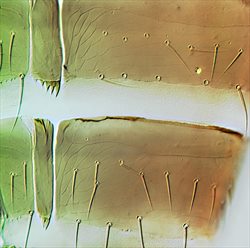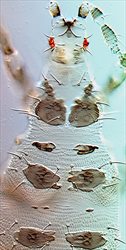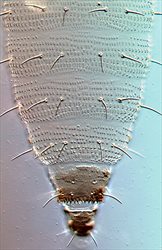
Antenna

Meso & metanota

Pleurotergites II-IV

Tergites VII-IX

Sternites VI-VII

Sternite V

Larva II head & thorax

Larva II abdomen

Fore wing
Both sexes fully winged. Body and legs brown, tarsi and apices of tibiae yellow, antennal segments II–III yellowish, paler than IV–VII; fore wings shaded, scarcely paler at base. Antennae 7-segmented; segments III–IV each with forked sense cone. Head with 2 pairs of ocellar setae; pair III arising on anterior margins of ocellar triangle, slightly shorter than side of ocellar triangle; postocular setae pairs I & III slightly longer than ocellar setae pair III, postocular setae pair II minute. Pronotum with 2 pairs of long posteroangular setae; posterior margin with 3 pairs. Mesonotum without anterior pair of campaniform sensilla, median setae in front of posterior margin. Metanotum with longitudinal reticulate sculpture medially; median setae arising near anterior margin; campaniform sensilla absent. Fore wing first vein with 7–11 setae on distal half; second vein with complete row of about 14 setae. Abdominal tergite II with 4 lateral marginal setae, V–VIII with paired ctenidia, on VIII posteromesad to spiracles; tergite VIII posteromarginal comb complete, microtrichia long; pleurotergites III–VI with 3–4 discal setae, posterior margin with microtrichia; tergite IX with 2 pairs of campaniform sensilla, X with median split. Sternites III–VII with irregular row of 16 or more discal setae; VII with setae S1 arising in front of margin.
Male smaller than female; tergite VIII without posteromarginal comb; sternites III–V with small oval pore plate.
Thrips is the second largest genus in the Thysanoptera, and currently includes, worldwide, over 290 species. All members of this genus lack ocellar setae I on the head, and they all have ctenidia on tergite VIII posteromesad to the spiracles. Other characters, such as number of antennal segments, number of setae on the fore wing veins, and number of discal setae on the sternites are variable between species (Palmer, 1992; Nakahara, 1994; Mound & Masumoto, 2005). Thrips minutissimus is one of the species of Thrips genus with discal setae on both sternites and pleurotergites, and is unusual amongst that group in having a large number of setae on the first vein of the fore wing.
Found in Spring, feeding and breeding in the flowers of its host plants. In Britain it was once thought to be specific to the catkins of Quercus robor [Fagaceae], but as on the mainland of Europe it is also found associated with various Rosaceae (zur Strassen, 2003), and even the catkins of Salix caprea [Salicaceae]. In Europe, it has also been recorded from Carpinus [Betulaceae].
Locally common and recorded widely in England and Scotland, from Kent to the northern Highland region (Mound et al., 1976). This species occurs throughout northern Europe, and is also reported from Iran.
THRIPIDAE - THRIPINAE
Thrips minutissimus Linnaeus
Thrips minutissimus Linnaeus, 1758: 457
Thrips minutissima var. obscura Coesfeld, 1898: 473
Bagnallia variabilis Williams, 1913: 227
Thrips evestigatus Oettingen, 1944: 41
Mound LA & Masumoto M (2005) The genus Thrips (Thysanoptera, Thripidae) in Australia, New Caledonia and New Zealand. Zootaxa 1020: 1–64.
Mound LA, Morison GD, Pitkin BR & Palmer JM (1976) Thysanoptera. Handbooks for the Identification of British Insects 1 (11): 1–79.
Nakahara S (1994) The genus Thrips Linnaeus (Thysanoptera: Thripidae) of the New World. United States Department of Agriculture. Technical Bulletin 1822: 1–183.
Palmer JM (1992) Thrips (Thysanoptera) from Pakistan to the Pacific: a review. Bulletin of the British Museum (Natural History) Entomology Series 61 (1): 1–76.
zur Strassen R (2003) Die terebranten Thysanopteren Europas und des Mittelmeer-Gebietes. Die Tierwelt Deutschlands 74: 1–271.